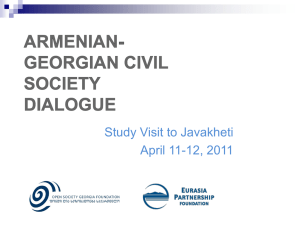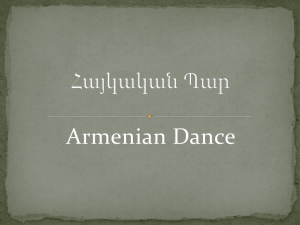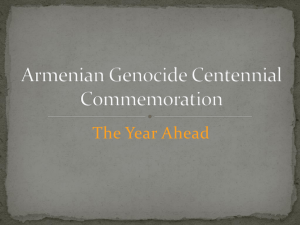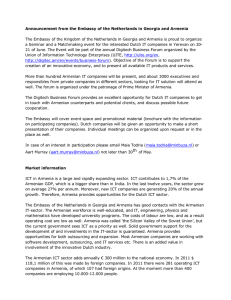Claude E. Cox: The Armenian Translation of the Bible.
advertisement
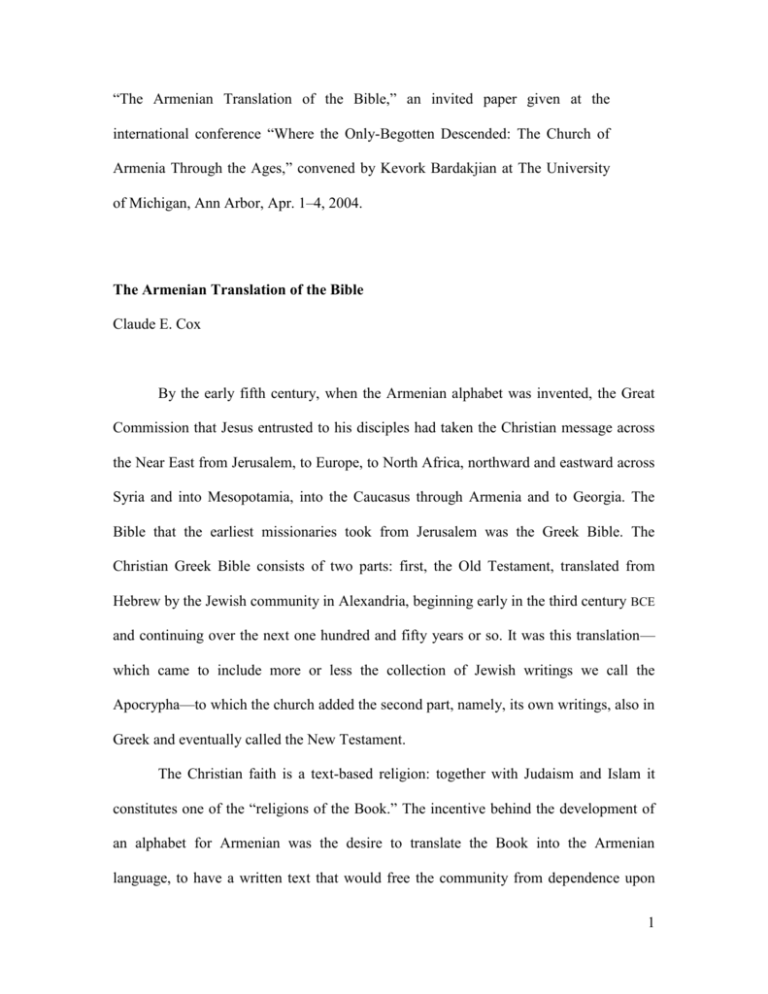
“The Armenian Translation of the Bible,” an invited paper given at the international conference “Where the Only-Begotten Descended: The Church of Armenia Through the Ages,” convened by Kevork Bardakjian at The University of Michigan, Ann Arbor, Apr. 1–4, 2004. The Armenian Translation of the Bible Claude E. Cox By the early fifth century, when the Armenian alphabet was invented, the Great Commission that Jesus entrusted to his disciples had taken the Christian message across the Near East from Jerusalem, to Europe, to North Africa, northward and eastward across Syria and into Mesopotamia, into the Caucasus through Armenia and to Georgia. The Bible that the earliest missionaries took from Jerusalem was the Greek Bible. The Christian Greek Bible consists of two parts: first, the Old Testament, translated from Hebrew by the Jewish community in Alexandria, beginning early in the third century BCE and continuing over the next one hundred and fifty years or so. It was this translation— which came to include more or less the collection of Jewish writings we call the Apocrypha—to which the church added the second part, namely, its own writings, also in Greek and eventually called the New Testament. The Christian faith is a text-based religion: together with Judaism and Islam it constitutes one of the “religions of the Book.” The incentive behind the development of an alphabet for Armenian was the desire to translate the Book into the Armenian language, to have a written text that would free the community from dependence upon 1 texts in Greek or Syriac and at the same time make the task of teaching the Christian faith much easier. Such a desire was shared with other nations to which the Gospel had gone. There was an Old Latin translation in the 2nd century and later, a Hebrew-based Latin translation for the Old Testament by Jerome in the 4th; translations into Coptic, for use in Egypt in the 3rd and early 4th century; an Ethiopic translation between the 4th and 6th centuries; a translation into Syriac, perhaps as early as the 2nd century.i Except for the work of Jerome, information about dates and translators of these various versions is either not extant, or hypothetical or the subject of continued debate. The Armenian tradition is different, thanks to Koriwn. The phenomenon of translation is at least as old as the Tower of Babel; since that time the task of communication has required translation. As in ancient times, so in modern times much human effort is put into bridging cultures and communities by the task of translation. Even today much of what we read, especially in the scholarly world, if not read in the original languages, is read in translation. That is true of the Bible also: virtually all of us read the Bible in translation from its original languages, Hebrew, Greek, and a small amount of Aramaic. The task of making the Bible available in translation still requires, in many instances, the preparing of an alphabet so that the message of the Bible can be printed in the language of the receptor community. So the story of the translation of the Bible into Armenian, and the other languages just mentioned, has its echo in the contemporary world. There are two primary sources for our understanding of the earliest translations of the Bible into Armenian: the first is Koriwn, who describes the events surrounding this work; the second is the texts themselves, i.e., the manuscripts which attest the work of 2 translation. Together they reveal a complex picture, whose main outline may be clear but whose details are not yet fully understood. Koriwn The circumstances surrounding the earliest translation of the Bible into Armenian are described in the course of Koriwn’s story about the invention of the alphabet by Mashtots‘. In 387 Armenia was divided between the Roman Empire and the Sassanid Kingdom of Persia; Koriwn’s account takes place against the backdrop of that political reality, which asserted itself in the use of different international languages among Armenians, namely, Greek and Syriac, respectively. From Koriwn’s story of Mashtots’ endeavours as a pious, active Christian, we may excerpt those parts that are of primary interest for our understanding of the translation of the Bible. One of the questions to which we would very much like an answer is whether the earliest translation work was done on the basis of Syriac or (and / or?) Greek parent texts. Koriwn does not specifically say, but one notices that his account has a decidedly westward looking stance, i.e., toward the Greek language. That said, from the outset we would expect a Syriac presence, since Armenia’s political and ecclesiastical circumstances incorporated Syriac as well as Greek. Perhaps Koriwn’s interest westward is part of the tendenz of his story. Koriwn relates that Mashtots‘ was from the village of Hats‘ekats‘ in Taron. He was tutored in Greek literature from his childhood, before he came to the court of the Arsacid kings in Armenia Major in the 390s.ii (Ch. 3)iii His evangelical concerns were shared by Sahak, the Catholicos, who had also received a Greek education,iv and by the 3 King, Vramshapuh. The King told them that a Syrian bishop named Daniel had an alphabet for Armenian. This was sent for, received, and employed for a period of time, but proved to be inadequate. (Ch. 6) Then Mashtots‘ went with pupils to Edessa and Amida, centers of Syriac learning. Mashtots‘ divided up his pupils into two groups: the first went to a Syrian school in Edessa; the second went to a Greek school in Samosata. (Ch. 7) It was then that Mashtots‘ invented the alphabet, in Edessa (?), in ca. 406. He travelled to Samosata, where he found a scribe of Greek, Hrop‘anos, who helped him with the script of his new alphabet. With the alphabet established, Mashtots‘ began to translate the Bible with the help of two pupils: Hovhan, from the province of Ekegheats‘, and Hovsep‘, from the house of Paghan. They started translating with the book of Proverbs, perhaps, as has been suggested, because it was the first book in a partial Bible. v (Ch. 8) Following this, Mashtots‘ returned to the Armenian capital, Vagharshapat; then, Koriwn says, he was at work translating, writing and teaching among the Mark‘. (Ch. 10) Various preaching trips are recorded, then Mashtots‘ travels to Melitene, and on to Constantinople. Here he is received by the Patriarch, Atticus (served 406–425) and prevails for help upon the Caesar, Theodosius II (408–450). Mashtots‘ returns home to Roman Armenia. (Ch. 16) He appoints pupils to oversee evangelical service and, with other pupils, makes his way to the capital in Persian Armenia, and presents himself to Sahak and the king. After some further journeys by Mashtots‘, he and Sahak devote themselves to improving the literary situation among their own people. For this purpose they send Hovsep‘ and Eznik to Edessa to translate “traditions of the holy fathers” from Syriac into Armenian— the Bible is not mentioned specifically. From there the translators travel to the “region of 4 the Greeks” and become proficient in translating from Greek. Others go to this same area, one being Ghewondes, and another, Koriwn, the author of the entire account, and they join Eznik in Constantinople—this will be in 429-30.vi Koriwn then provides some crucial information: the pupils returned to Armenia with “reliable copies of the Godgiven writings,” i.e., manuscripts of the Greek Bible, together with traditions of the church fathers, and the canons of church councils at Nicea (325) and Ephesus (331), “and they placed before the Fathers the testaments of the holy church which they had brought.vii (Ch. 19) Next, Koriwn states that: the blessed Sahak, who earlier had rendered the collection of ecclesiastical books from the Greek language into Armenian—as well as much true wisdom of the holy patriarchs—again, with Eznik, set himself to establish the earlier, chancedupon and hurried translations by means of the true exemplars which had been brought. And they also translated much commentary on the Bible. This intriguing summary tells us that Sahak had worked from Greek texts; now, he and Eznik established what had been translated earlier on the basis of “the true (accurate?) copies” brought back from Constantinople. What exactly does hastatel (“to confirm, establish”) mean in this context? Did they revise all the previous work? Or, was this more of a consolidation of work done earlier, more a “making sure of” the adequacy of work done before? How extensive was this new work? Had everything been translated before? And what do the designations hastatun (“reliable”) and jshmarit (“true”) mean? Do these characterizations indicate that the copies enjoyed some sort of official status in 5 Constantinople? Or that they came with the blessing of church authorities there? We are left to wonder. At any rate, through the work of Mashtots‘ and Sahak, the great figures of the Bible began to speak Armenian. Koriwn states that Moses (i.e., the Pentateuch), the prophets (i.e., the prophetic books of the Old Testament), Paul (i.e., the writings of the New Testament attributed to Paul) and the apostles (i.e., other writings of the New Testament), and Christ (i.e., the four Gospels) were now read and heard in Armenian. (Ch. 11)viii Throughout his account, it strikes the reader that Koriwn accents the contacts with the West, with Greek: Mashtots‘ is tutored in Greek from childhood. After he invents the alphabet, Mashtots‘ journeys to Samosata, where he had sent pupils to study in a Greek school. In Samosata, he finds a Greek scribe, who helps refine the writing of the letters of the newly developed alphabet. Mashtots‘ returns from Constantinople with books of the church fathers (Greek). Hovsep‘ and Eznik travel to Edessa to translate traditions of the church fathers from Syriac, but then go on to the region of the Greeks and become proficient in Greek. Ghewondes, Koriwn, and Eznik go to Constantinople and return with Bible manuscripts, “reliable copies”. Sahak is said to have translated ecclesiastical books and the wisdom of the church fathers from Greek. 6 The only translation work specifically said to have been from Syriac is that of Hovsep‘ and Eznik, namely, traditions of the church fathers. Koriwn’s account is decidedly westward looking. There is a second important observation to be made from Koriwn’s account. We are provided with the names of the translators of the Bible, at least some of them: Mashtots‘ himself, pupils Hovhan and Hovsep‘; Sahak and Eznik. In this respect the translation of the Bible into Armenian stands apart from other versions, whose translators in virtually every case remain anonymous. That the translation was the work of these towering figures meant that it was lent an authority which protected its text from serious, thoroughgoing revision after the middle of the 5th century. The early translations had a “canonical” status in the community. The story of the translation of the Bible is also related by Lazar of P‘arp and by Moses Khorenats‘i, but they are both dependent on Koriwn.ix The Manuscript Tradition The manuscripts themselves represent the primary witness to the Armenian translation of the Bible. Armenian translators seem to have had as their goal to translate everything they could lay their hands on into Armenian. If this was the intention, they were successful. Not only the Bible itself, but commentary sources in Greek and Syriac, and much else, were rendered into Armenian, so that John Chrysostom, Gregory of Nazianzus, Ephrem, Philo, and many others are preserved in Armenian, sometimes uniquely.x At the same time there developed a home-grown scholarship that eventually 7 produced commentary materials as well as an apocryphal tradition devoted to such figures as Adam and Eve. Our interest here is specifically the Bible, of which some hundred or so complete copies are extant. A manuscript containing the complete Bible is a relatively late form of manuscript in Armenia; it appears in the early 13th century. Before that time biblical manuscripts circulated as smaller collections, like the Gospels, or the Wisdom books of the Old Testament. We would expect there to be more Gospel manuscripts than any other type of partial Bible and that is the case: they number more than 2,000, dating from the 9th century and later.xi The sheer numbers of manuscripts, while attesting the strength of scribal tradition, make the preparation of editions of these texts a daunting task. No manuscripts from the 5th century have survived. We are dependent upon much later witnesses. The same holds true for the Hebrew Bible, the Greek Bible, and the Syriac translations like the Peshitta. Further, from the beginning the text of the Bible in these various languages was not completely stable, nor was the concept of “canon,” i.e., the idea of an authoritative list of Scripture books, established at one time everywhere. The Old Testament part of the traditional Greek Bible, the Septuagint, underwent various kinds of revision, usually toward the Hebrew text; likewise the Old Syriac underwent a revision on the basis of the Greek Bible to produce the Peshitta in the early decades of the 5th century, the very period of the translation of the Bible into Armenian.xii This textual situation means that researchers are working on several slippery slopes at the same time. The fluidity of the textual traditions means that critical editions of the relevant texts are essential. Much of the work done on the Armenian translation of the Bible in the past was done before there were critical editions of the Greek (that project for the Old Testament, 8 based in Göttingen, is not finished even now), Syriac (a “diplomatic” edition of the Peshitta Old Testament, produced by the Peshitta Institute in Leiden, has been completed; no critical edition exists yet), or Armenian witnesses; further, the historical sources, Koriwn, Lazar of P‘arp, and Moses Khorenats‘i, were not treated critically, which makes older works dated and sometimes useless. A good example of a failure in methodology is Ter Petrosyan’s study of the minority text of Chronicles. He argues for a Syriac parent text, based on a comparison with the Peshitta, but does not pursue the possibility that such agreements might be shared in the Greek tradition. Indeed, as Cowe demonstrated, the parent text of that earlier Armenian version of Chronicles derives from a Greek text as revised by Lucian of Antioch at the beginning of the 4th century.xiii There is no question that the work of translation based on manusripts brought back to Armenia after the Council of Ephesus (431) represents a watershed in the textual tradition of the Armenian Bible. Following the ground-breaking work of Lyonnet on the Gospels, it is customary to speak of the biblical translation that was “finalized” after 431 as Arm 2.xiv This was Greek-based, i.e., we are told that earlier translation work was “established” (revised?) on the basis of manuscripts brought back from Constantinople, manuscripts which were of some kind of type of text. This work should probably be thought of as part of a process: Arm 1 and Arm 2 are not necessarily two distinct stages. There is a tendency to think of Arm 1 as Syriac-based and Arm 2 as a Greek-based revision of that earlier Syriac-based work of translation. But the textual situation is more complex than that. To cite the example just offered, the “other” text of Chronicles represents Arm 1 but is Greek-based; and the earliest stratum of Daniel, in Cowe’s view, derives from a simultaneous translation from the Peshitta and a Lucianic Greek text.xv 9 It is probably premature to draw into consideration issues of canon in postulating what and what not was part of Arm 1, e.g., to exclude the Apocrypha from the earlier stages on the basis of the canon of the Peshitta.xvi From Koriwn we might conclude that, from the earliest efforts at translation, Greek parents texts were being used, though probably not exclusively so. Those Greek parent texts would have included the Apocrypha, whose contents circulated along with the books that are part of the smaller Hebrew collection. For the New Testament, the presence of 3 Corinthians in Armenian manuscripts has been thought to indicate a Syriac-based translation,xvii but Cowe, in a comparative study of the Armenian, states that, in it, “one would be hard put to isolate traces of syriacism,” which, at the same time, “seems to emerge with a profile increasingly reminiscent of Arm 1,” xviii that is to say, it seems that this text, which appears to be Arm 1, is Greek-based. Armenian 1 It will be clear by now that the Armenian biblical textual tradition is complex, but careful research can yield solid results. The books of the Armenian Bible really must be approached on an individual basis: broad generalizations will not suffice. In trying to establish the earliest Armenian text, the question arises about how to “get behind” the later form of the text as represented, for example, in Zohrapian’s edition of the Bible which is, in turn, a faithful reproduction of a medieval manuscript. Lyonnet’s study of the Gospels may well be taken as a model. Lyonnet “gets behind” the manuscript tradition of the Gospels, as represented, e.g., in Zohrapian’s edition, by examining: quotations from the Gospels in Armenian writers, such as Eznik; 10 works translated from Greek into Armenian, such as John Chrysostom’s sermons, where the translator provided the biblical text according to what was familiar in Armenian; works translated from Syriac, such as Ephrem, where the same phenomenon may be observed; the Georgian version, whose parent text was an Armenian text, and which preserves readings like those in the preceding sources; liturgical materials, which preserve a textual tradition independent of the biblical manuscripts; the biblical manuscripts preserve some readings from the old translation, Arm 1. This study is a model of good methodology. Among his conclusions, Lyonnet states that the parent text of Arm 1 in the Gospels was certainly an old Syriac text and calls our attention to a number of traits of the earlier translation: the use of a finite verb rather than a circumstantial participle; the addition of personal pronouns after the verb; the frequent addition of ;j; (et‘e) “that” to introduce a citation (corresponding to d in Syriac); phrases like “land of the Egyptians,” “regions of the Galileans”; the orthography of proper nouns (e.g., Isafak (Isahak), as opposed to Safak (Sahak)[Arm 2]); frequent alterations between singular and plural created by confusion in Syriac manuscripts, where the marker of plurality is easily lost or added; syriacisms, like the repetition of cognates as in gor/ gor/h (gorts gortsé ) “(our Father) works work” (John 5:17).xix Lyonnet, on the basis of his study, believes it likely that there existed at first in Armenian a harmony of the Gospels, a diatessaron, rather than four separate Gospels, and that it was certainly a translation from Syriac. His case is convincing. A Syriac 11 substratum has been determined in other books of the New Testament as well—for example, Actsxx—but, once again, such a conclusion for the Gospels and Acts does not necessarily hold true for other parts of the New Testament: for James, Burchard is quite negative about finding any traces of an earlier translation in the textual tradition, if the evidence of such a Syriac-based Arm 1 is supposed syriacisms in the text we have.xxi Armenian translators were adept at translating works from Syriac into Armenian and, from the outset, one would expect the translation of biblical materials. Since translation work on the Bible after 431 was Greek-based—though not necessarily exclusively so!— we would expect Syriac evidence to belong to an earlier phase. As we have seen, however, the textual situation is complex and only painstaking, careful work can elucidate it, because Armenian translators knew Syriac and Syriac exegetical traditions; the ecclesiastical vocabulary of early Armenian Christianity is often Syriac—e.g., k‘ahana “priest,” or p‘rkel “to save”;xxii further, Syriac syntactical constructions could influence translation work, without there being a Syriac parent text at hand. Certainly the double textual traditions of Chronicles, Ecclesiastes, and Song of Songs invite disciplined analysis and the preparation of editions. From Armenian 1 to Medieval “Study Bibles” The earliest efforts at translating the Bible went through a consolidation after 431. Then, over a period of centuries, what we call Armenian 2 almost completely replaced Armenian 1, which can still be found in the biblical manuscripts in scattered readings or, perhaps, as in the case of Chronicles, as an entire text in a few manuscripts. For some biblical books, the manuscripts that the seminarians brought back from Constantinople 12 seem to have been of a decidedly “hexaplaric” text type, that is, they reflect the work of the great third century text critic, Origen, though one should add, the so-called Lucianic text has a hexaplaric component. It may be such a type of text that is designated “reliable” and “true” by Koriwn. Origen prepared a huge book in six columns. From the left it comprised the Hebrew of his day; the Hebrew transliterated into Greek; translations by Aquila, then Symmachus; the traditional Greek text of the Old Testament, known as the Septuagint, since by legend it was rendered into Greek by seventy Jewish translators; and, finally, another translation bearing the name of an individual, Theodotion. The text of the Old Testament appeared word after word, or phrase after phrase, down the page within the columns. Now, it happens that the Old Greek text is not always of the same length as the Hebrew, so Origen used critical signs to note where the Septuagint was longer and, where it was shorter, he added, from Theodotion, to bring the fifth column to the same length as the Hebrew. Again, he marked his additions with critical signs. These signs, known respectively as an obelus ( ò ) and asterisk ( ì ), were placed before the word or phrase; the word(s) in question were followed by another sign, called a metobelus ( ù ). Armenian manuscripts of the Old Testament preserve these signs in greater or lesser numbers in many books, at times uniquely, because they have sometimes been lost even from the Greek tradition. The medieval period was an active one in Armenian scriptoria. The one-volume Bible appeared in the 13th century, and introductions to the various books and lists of chapters were introduced by Georg Skewrats‘i. Chapter and verse divisions were added on the basis of the Latin Vulgate—making the use of the text much easier. The tradition 13 of manuscript ornamentation, through the incorporation of miniatures, was refined. Armenian manuscripts were compared among themselves, and marginal readings that cite the differences appear in Cilician manuscripts. Marginal notations that provide translations—usually only one word—from Aquila, Symmachus, and Theodotion were likely added in this same period, thus preserving, sometimes uniquely, valuable text critical information. So it is that the Armenian Bible takes on the character of a modern study Bible! From Manuscript to Edition There have been two principle editions of the Bible in classical Armenian: that of Oskan, published in Amsterdam in 1666, which printed the manuscript now numbered 180 in the Matenadaran collection and into which its editor introduced many “corrections” based on the Latin Vulgate; and that of Zohrapian, printed in Venice in 1805. The latter is a magnificent work of scholarship for its day; it faithfully reproduces the text of Venice manuscript 1508, dated 1319. In an apparatus at the bottom of the page, Zohrapian cites major variant readings among a larger group of manuscripts that he examined, some eight plus Oskan for the Old Testament, almost thirty for the Gospels, and some forty for the Epistles.xxiii Unfortunately, the type of text that Venice 1508 represents is often a less pure form of text than that of some other manuscripts—such as Jerusalem 1925—and the manuscripts he cites in his apparatus are identified only in general terms, but Zohrapian’s work is still the starting point for all modern text-critical work on the Bible. A new, critical edition of the Bible in classical Armenian is badly needed. 14 One of the issues that Zohrapian faced was that of “canon,” that is, which books should be included as authoritative. Septuagint manuscripts include the so-called Apocrypha, but other writings like “The Letter of Jeremiah” circulated in manuscripts, including Armenian manuscripts. It was not really until the fourth century that the western church finalized its canon, and Armenian canon lists of the medieval period are not necessarily a reliable guide to usage.xxiv Zohrapian placed Sirach in an appendix, following the New Testament, along with The Words of Sirach; Third Ezra (i.e., the apocalyptic Fourth Ezra); The Prayer of Manasseh; The Letter of the Corinthians to the Holy Apostle Paul; The Rest of Holy John, Apostle and Evangelist; and The Petition of Euthalius. Aside from Sirach, Zohrapian’s edition follows the Septuagint “canon” in its inclusion of Second Ezra (i.e., 1 Esdras), Judith, Tobit, 1–3 Maccabees, the Wisdom of Solomon, and Baruch. Today the major collections of Armenian biblical manuscripts are found in Yerevan—the largest, Jerusalem, Venice, Vienna, and Isfahan. Individual manuscripts may be found occasionally outside these collections: e.g., the British and Foreign Bible Society, in London, England, has a complete Bible, as does the British Library, also in London. There are catalogues for all these collections, as well as a single catalogue that embraces almost all the complete and partial Bibles, except for partial and complete New Testament manuscripts.xxv The Library of Congress in Washington, D.C., has microfilms of Jerusalem manuscripts, including Jerusalem 1925; the Hill Monastic Library, in Collegeville, MN, also has microfilms and is in the process of digitizing; the Association des Études Arméniennes, whose resources are based in Leiden, has on file such microfilm and copy resources as are in the hands of individual scholars. 15 The Armenian biblical tradition fostered the writing of commentaries on biblical books, as well as the production of a rather vast apocryphal tradition. All this began with the explosion of activity in the 5th century following the invention of the alphabet. Remarks here have focused on the early period and followed the course of the classical language into editions, but it should be said that there have been various successful efforts at translation of the Bible into modern Armenian, eastern and western.xxvi Conclusion The first literature to appear in the alphabet created by Mashtots‘ for the Armenian language was the Bible. No effort was spared in the translation into Armenian of the biblical books and any literature related to it. So it is that from the beginning the Bible has been at the centre of Armenian spiritual, philosophical, intellectual and artistic life. During times when national identity and survival have been threatened, the Bible has been a source of strength and comfort. Today the field of Armenian biblical studies is a rich area that awaits exploration. The principal requirements are language skills and training in the textual criticism of the Bible. The rewards include an understanding of the history of the text of one of the early versions of the Bible, and participation in an interested community of scholars and nonspecialists. Select Bibliography Abeghyan, M. Vark‘ Mashtots‘ (Life of Mashtots). Yerevan: Haypethrat, 1941. 16 Anassian, H.S. Astuatashunch‘ Mateani Haykakan Bnagire (Matenagitut‘iwn) (The Armenian Text of the Bible [Bibliography]). “Haykakan Matenagitut‘ean” B. Yerevan: Academy of Sciences of the Armenian SSR, 1976. Burchard, Christoph, ed. Armenia and the Bible. University of Pennsylvania Armenian Texts and Studies 12. Atlanta, GA: Scholars Press, 1993. Cowe, S. Peter. “Problematics of Edition of Armenian Biblical Texts,” in Armenian Texts. Tasks and Tools, ed. Henning Lehmann and J.J.S. Weitenberg. Acta Jutlandica LXIX:1; Humanities Series 68. Aarhus: Aarhus University Press, 1993. Pp. 26-37. _____. The Armenian Version of Daniel. University of Pennsylvania Armenian Texts and Studies 9. Atlanta, GA: Scholars Press, 1992. See especially, “General Conclusion,” pp. 419-453. Thomson, Robert W. “The Fathers in Early Armenian Literature,” Studia Patristica XII, Part I, ed. Elizabeth A. Livingstone. Berlin: Akademie-Verlag, 1975. Pp. 457-470. i The dates for the various versions are drawn from, respectively, Pierre-Maurice Bogaert, “Versions, Ancient (Latin)”; Watson E. Mills, “(Coptic)”; Rochus Zuurmond, “(Ethiopic)”; S. P. Brock, “(Syriac),” in The Anchor Bible Dictionary, ed. David Noel Freedman (New York: Doubleday, 1992), vol. 6, pp. 794-810. ii The dates provided here follow Krikor H. Maksoudian, “Koriwn,” in Studies in Classical Armenian Literature, ed. John A. C. Greppin (Delmar, NY: Caravan Books, 1994), pp. 101-127. For a review of several publications on Koriwn, see Jean-Pierre Mahé, “Quatre Nouvelles Publications (1990–1994) sur Koriwn,” Revue des Études Arméniennes 25 (1994-1995), pp. 417-428. 17 iii The account provided here follows M. Abeghyan, Vark‘ Mashtots‘ (Life of Mashtots) (Yerevan: Haypethrat, 1941). A popular-level English translation is available in Koriun. The Life of Mashtots, tr. Bedros Norehad[ian] (New York: Armenian General Benevolent Union, 1964), which is based upon Abeghyan’s edition and provides a translation of the introduction from that work as well as some of its notes. iv Abeghyan, Vark‘, p. 107, n. 57 = Norehad, Koriun, p. 53, n. 10. v The suggestion was made by F. C. Conybeare, “Armenian Version of the OT,” A Dictionary of the Bible, ed. James Hastings (New York: Charles Scribner’s Sons; Edinburgh: T. & T. Clark, 1905), vol. 2, p. 152. Conybeare thinks they used the second part of a Bible that was complete in two volumes. In fact, the manuscript may have contained much less than that. vi Maksoudian, “Koriwn,” p. 104. vii Abeghyan takes “testaments” to refer especially to the Old and New Testaments: p. 118, n. 123. viii M. Ter-Movsessian, Istoriia Perevoda Biblii na Armianskii Yasyk (History of the Translation of the Bible into the Armenian Language) (St. Petersburg: Pyshkinskaia Skoropechatnia, 1902), p. 8. It is Ter-Movsessian’s insight that Koriwn reveals here what biblical books were translated into Armenian and that this was the work of “two equals”. An English translation of Ter-Movsessian’s book would be a great help to all students of the Armenian Bible. ix Lazar condenses Koriwn’s account and attributes the translation of the Bible to Sahak, who translates once, from Greek: Ghazar P‘arpets‘i, Patmagirk‘ Hayots‘ (History of the Armenians), ed. G. Ter-Mkrtch‘ean and St. Malkhasean (Tiflis: Aragatip Mnats‘akan 18 Martiroseants‘i, 1904), p. 16. Moses says that when Mashtots‘ returned to Armenia after translating the Bible in Syria, he found Sahak engaged in translating from Syriac. See Moses Khorenats‘i. History of the Armenians, tr. and commentary by Robert W. Thomson (Cambridge, MA; London: Harvard University Press, 1978), III, 54 (p. 322). x For a useful introduction to patristic materials preserved in Armenian, see Robert W. Thomson, “The Fathers in Early Armenian Literature,” Studia Patristica, XII, Part I, ed. Elizabeth A. Livingstone (Berlin: Akademie-Verlag, 1975), pp. 457-470. xi Joseph M. Alexanian, “Versions (Ancient), Armenian,” Anchor Bible Dictionary, vol. 6, p. 807, states that Armenian biblical manuscripts number more than 2,500, of which some 2,100 are Gospels. xii xiii Brock, “Versions, Ancient (Syriac),” Anchor Bible Dictionary, vol. 6, p. 797. L. H. Ter Petrosyan, “La plus ancienne Traduction des ‘Chroniques’,” in Essays in honour of Archbishop Norayr Bogharian, ed. Michael E. Stone and S. Peter Cowe = Revue des Études Arméniennes, N.S. 18 (1984), pp. 215-225; S. Peter Cowe, “The Two Armenian Versions of Chronicles, Their Origin and Translation Technique,” Revue des Études Arméniennes, N.S. 22 (1990-91), pp. 53-96). Ter Petrosyan is a serious scholar, but in his article he was simply repeating a long-standing assertion; that it was longstanding did not make it correct. xiv S. Lyonnet, Les Origines de la Version arménienne et le Diatessaron (Biblica et Orientalia 13; Rome: Pontificio Instituto Biblico, 1950). xv S. Peter Cowe, The Armenian Version of Daniel (University of Pennsylvania Armenian Texts and Studies 9; Atlanta, GA: Scholars Press, 1992), p. 420. 19 xvi As does Anassian, in his helpful introduction to the Armenian text: H. S. Anassian, Astuatashunch‘ Mateani Haykakan Bnagire (Matenagitut‘iwn) (The Armenian Text of the Bible [Bibliography]) (“Haykakan Matenagitut‘ean” B; Yerevan: Academy of Sciences of the Armenian SSR, 1976), cols. 311-314, on the basis of Moses Khorenats‘i; see also cols. 315–316, where he attributes the translation of the Apocrypha to the postEphesus period of translation. xvii For example, Alexanian, “Versions, Ancient (Armenian),” p. 806. xviii S. Peter Cowe, “Text Critical Investigation of the Armenian Version of Third Corinthians,” St. Nersess Theological Review 2 (1997), pp. 42, 51. xix Lyonnet, Les origines de la Version arménienne, pp. 51-54; the citation is from p. 23. For a more extensive listing of the characteristics of Arm 1 in comparison with Arm 2, see Cowe, “The Two Armenian Versions of Chronicles”; “La versión armenia,” in Natalio Fernández Marcos and José Ramón Busto Saiz, with the collaboration of María Victoria Spottorno Díaz-Caro and S. Peter Cowe, El Texto Antioqueno de la Biblia Griega. III 1–2 Crónicas (Textos y Estudios «Cardenal Cisneros» de la Biblio Políglota Matritense 60; Madrid: Instituto de Filología Del CSIC, 1996), pp. XLVIII-LV (in English); The Armenian Version of Daniel, pp. 357-372, 428-432. Edward G. Mathews, Jr., in “Early Armenian and Syrian Contact: Reflections on Koriwn’s Life of Mashtots,” St. Nersess Theological Review 7 (2002), p. 12, rightly points out that the minority text of Chronicles does not come with a label “Arm 1,” but has simply been presumed. However, that this translation has the characteristics recognized as belonging to Arm 1 elsewhere makes such an identification likely. 20 xx Gerard Garitte, L’ancienne Version géorgienne des Actes des Apôtres d’après deux manuscrits du Sinaï (Bibliothèque du Muséon 38; Louvain: Publications Universitaires / Institut Orientaliste, 1955). xxi Christoph Burchard, “Zur altarmenischen Übersetzung des Jakobusbriefes,” in Horizonte der Christenheit. Festschrift für Friedrich Heyer zu seinem 85. Geburtstag, ed. Michael Kohlbacher and Markus Lesinski, Oikonomia 34 (Erlangen, 1994), p. 206. xxii Other examples can be found in Mathews, “Early Armenian and Syrian Contact,” p. 8, citing E. Ter-Minassiantz, Die Armenische Kirche in ihren Bezeihungen zu den Syrischen Kirchen bis zum Ende des 13. Jahrunderts (1904), pp. 11-12. Mathew’s article is a helpful introduction to early biblical materials that came into Armenian from Syriac. xxiii H. Zohrapian, ed., Astuatsashunch‘ Matean ew Nor Ktakaranats‘ (Scriptures of the Old and New Testaments) (Venice, 1805); repr., with an introduction by C. Cox (Classical Armenian Text Reprint Series; Delmar, NY: Caravan Books, 1984), p. xiv. xxiv Michael E. Stone has published a series of articles in Harvard Theological Review on the canon lists, beginning with “Armenian Canon Lists I—The Council of Partaw (768 C.E.),” in vol. 66 (1973), pp. 479-486. These articles are to become a book on the Armenian canon. xxv Shahé Ajamian, Ts‘uts‘ak Astuatsashunch‘ Mateani Hayeren Dzeragirnerun (Catalogue of Armenian Biblical Manuscripts) (Lisbon: C. Gulbenkian Foundation, 1992). xxvi See Manuel M. Jinbachian, “Modern Armenian Translations of the Bible,” in Armenia and the Bible, ed. Ch. Burchard (University of Pennsylvania Armenian Texts and Studies 12) (Atlanta, GA: Scholars Press, 1993), pp. 97-123. 21


